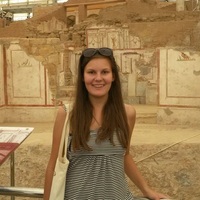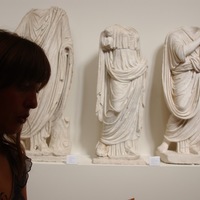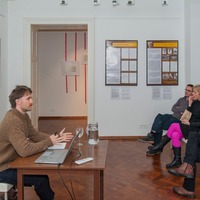
Iva Kaić
Related Authors
Mirna Cvetko
University of Zagreb, Faculty of Humanities and Social Sciences [Filozofski fakultet]
Domagoj Toncinic
University of Zagreb, Faculty of Humanities and Social Sciences [Filozofski fakultet]
Sanja Ivcevic
Archaeological museum in Split
Rebecca H Jones
National Museums Scotland
Zrinka Buljević
Archaeological museum in Split
István Gergő Farkas
University of Pecs
Ewan S Coopey
Macquarie University
Marta Prevosti
Institut Català d'Arqueologia Clàssica
InterestsView All (21)










Uploads
Papers by Iva Kaić
of Roman-era intaglios and cameos in Croatia. In the
Museum’s hand-written gem inventory, known as “Catalogue
I”, Fr. Frane Bulić registered a total of 2,559 gems, of which 35
are cameos. Up to the present, 17 cameos have been preserved
and they have been partially published or their publication is
pending. The remaining four cameos and one plaster cast from
that inventory list are covered in this paper. The find-spots of
two examples from this group have been recorded (Split and
Konjsko), while this information has not been preserved for the
other three. The cameo bearing the head of a boy/Eros and the
inscription ΤΥΧΗ/ΚΑΛΗ dates to the Roman era, as does the
plaster cameo featuring an erotic motif of a satyr and maenad.
The cameo with a bust of a young African man and the cameo
featuring a laureate man’s head date to the Early Modern period.
prezentaciju povijesno-kulturne materijalne i nematerijalne baštine. Njihovim ciljanim i smislenim implementiranjem
u arheološku i muzejsku djelatnost kreira se nova domaća i inozemna muzejska publika koja preferira online
dostupnost informacija i samostalno istraživanje tamo gdje i onda kada sama to želi. Projekt informatizacije i
digitalizacije Muzeja triljskog kraja sadrži mrežnu stranicu kao svojevrsnu „osobnu kartu“ muzeja, tehnološki
vrhunski razvijenu virtualnu šetnju po muzejskom prostoru i postavu te mobilnu aplikaciju 3D-3LJ – Muzej triljskog
kraja i rimski legijski logor Tilurij razvijenu u suradnji s Odsjekom za arheologiju Filozofskog fakulteta Sveučilišta u
Zagrebu. Virtualna šetnja osmišljena je da korisnika potakne na fizički posjet Muzeju te da on kroz interaktivne info
točke dobije osnovne informacije o muzejskim zbirkama i postavu te iz udobnosti svog doma ostvari prvu
komunikaciju s našim muzejom. S duge strane, mobilna aplikacija 3D-3LJ – Muzej triljskog kraja i rimski legijski
logor Tilurij, zainteresiranim posjetiteljima arheološkog nalazišta Tilurij pruža mogućnost samostalnog učenja i
istraživanja lokaliteta.Tri navedena alata zajedno čine zaokruženu cjelinu koja posjetiteljima muzeja i/ili arheološkog
lokaliteta omogućuju da sami filtriraju i izaberu informacije i sadržaje koji ih zanimaju te dožive poučno i ugodno
iskustvo. U procesu prikupljanja podataka za izradu digitalnih sadržaja, korištena je metoda studije slučaja te
metode analize i sinteze, tj. induktivni pristup pri njihovoj interpretaciji.
The problem here lies in the representation of a dolphin. The motif was named “the Eucharist dolphin” although not attested on the Early Christian frescoes depicting the Eucharist, agape, or funeral banquets, nor on the Early Christian gems, which frequently depict dolphins either with anchors or with a Christian inscription. J. Spier, therefore, leaves the issue of the ascription of the Salona carnelian to early Christianity unresolved, categorising it as a 3rd century gem.
However, after turning away from the idea of an Early Christian motif, the iconographic analysis of Roman gems depicting tripods showed that the motif carved into the Salona carnelian actually represents neither fish nor dolphin, but rather a different kind of an animal. It is, unquestionably, a mouse, commonly depicted on tripods either standing or nibbling on a piece of bread. From this, we can conclude that the Salona carnelian should not be considered anymore as an Early Christian gem nor as depicting a so-called Eucharist dolphin. Instead, it should be included in the group of Roman gems engraved with a mouse on a tripod.
Keywords: intaglio, glyptics, Early Christianity, Roman period, eucharist, fish, dolphin, tripod, mouse
Aus dem Gebiet des Dorfes Gardun in Kroatien, wo in der Antike das römische Militärlager Tilurium gebaut wurde, stammt, unter anderen römischen Funden, auch eine große Zahl der Gemmen. Beim Großteil handelt es sich um Zufallsfunde ohne archäologischen Kontext, doch kann aufgrund des Fundortes davon ausgegangen werden, dass sie einst im Besitz von römischen Soldaten waren. Unter diesen Gemmen, finden wir auch solche die erotische bzw. sexuelle Symbolik nachweisen. Es handelt sich um vier Intaglienderen Darstellungen von leicht erotischen (Venus pudica, Cupid der einen Schmetterling mit einer Fackel verbrennt, Nymphe Amymone) bis starken sexuellen (Satyrn und Mänaden) sind. Diese Intaglien sind in der Zeit vom 1. Jh. vor Christus bis. 1. Jh. nach. Christus datierbar.
Given that the Roman gems from Sisak, mainly for the lack of publication, are so far a little-known category of ancient findings from the Roman Siscia, a collection of Roman intaglios from the Sisak City Museum is an important contribution to the further study of iconographic, stylistic and technical characteristics of the glyptic of Siscia.
Nella collezione del convento di S. Francesco nella città di Imotski (situata nel retroterra dalmata, al confine della Croazia con la Bosnia e Herzegovina) sono conservati dei doni votivi dedicati alla Madonna, esposti in una vitrina a parte. Si tratta di gioielli, per lo più anelli d’oro incastonati con pietre preziose, poi in minor numero di orecchini e collane, e infine di piccolo oggetti sacrali di uso personale, come crocifissi e rosari. Non sono conosciuti né i dati sui dedicanti, né l’epoca della donazione degli oggetti, come neppure informazioni sul luogo della loro provenienza. Nel presente lavoro vengono analizzati 22 intagli usati come decorazione su anelli ed un orecchino. Sia gli anelli che l’orecchino rappresentano una produzione moderna, a differenza degli intagli, databili nell’epoca romana e post-classica, per cui sono analizzati secondo il criterio cronologico.
of Roman-era intaglios and cameos in Croatia. In the
Museum’s hand-written gem inventory, known as “Catalogue
I”, Fr. Frane Bulić registered a total of 2,559 gems, of which 35
are cameos. Up to the present, 17 cameos have been preserved
and they have been partially published or their publication is
pending. The remaining four cameos and one plaster cast from
that inventory list are covered in this paper. The find-spots of
two examples from this group have been recorded (Split and
Konjsko), while this information has not been preserved for the
other three. The cameo bearing the head of a boy/Eros and the
inscription ΤΥΧΗ/ΚΑΛΗ dates to the Roman era, as does the
plaster cameo featuring an erotic motif of a satyr and maenad.
The cameo with a bust of a young African man and the cameo
featuring a laureate man’s head date to the Early Modern period.
prezentaciju povijesno-kulturne materijalne i nematerijalne baštine. Njihovim ciljanim i smislenim implementiranjem
u arheološku i muzejsku djelatnost kreira se nova domaća i inozemna muzejska publika koja preferira online
dostupnost informacija i samostalno istraživanje tamo gdje i onda kada sama to želi. Projekt informatizacije i
digitalizacije Muzeja triljskog kraja sadrži mrežnu stranicu kao svojevrsnu „osobnu kartu“ muzeja, tehnološki
vrhunski razvijenu virtualnu šetnju po muzejskom prostoru i postavu te mobilnu aplikaciju 3D-3LJ – Muzej triljskog
kraja i rimski legijski logor Tilurij razvijenu u suradnji s Odsjekom za arheologiju Filozofskog fakulteta Sveučilišta u
Zagrebu. Virtualna šetnja osmišljena je da korisnika potakne na fizički posjet Muzeju te da on kroz interaktivne info
točke dobije osnovne informacije o muzejskim zbirkama i postavu te iz udobnosti svog doma ostvari prvu
komunikaciju s našim muzejom. S duge strane, mobilna aplikacija 3D-3LJ – Muzej triljskog kraja i rimski legijski
logor Tilurij, zainteresiranim posjetiteljima arheološkog nalazišta Tilurij pruža mogućnost samostalnog učenja i
istraživanja lokaliteta.Tri navedena alata zajedno čine zaokruženu cjelinu koja posjetiteljima muzeja i/ili arheološkog
lokaliteta omogućuju da sami filtriraju i izaberu informacije i sadržaje koji ih zanimaju te dožive poučno i ugodno
iskustvo. U procesu prikupljanja podataka za izradu digitalnih sadržaja, korištena je metoda studije slučaja te
metode analize i sinteze, tj. induktivni pristup pri njihovoj interpretaciji.
The problem here lies in the representation of a dolphin. The motif was named “the Eucharist dolphin” although not attested on the Early Christian frescoes depicting the Eucharist, agape, or funeral banquets, nor on the Early Christian gems, which frequently depict dolphins either with anchors or with a Christian inscription. J. Spier, therefore, leaves the issue of the ascription of the Salona carnelian to early Christianity unresolved, categorising it as a 3rd century gem.
However, after turning away from the idea of an Early Christian motif, the iconographic analysis of Roman gems depicting tripods showed that the motif carved into the Salona carnelian actually represents neither fish nor dolphin, but rather a different kind of an animal. It is, unquestionably, a mouse, commonly depicted on tripods either standing or nibbling on a piece of bread. From this, we can conclude that the Salona carnelian should not be considered anymore as an Early Christian gem nor as depicting a so-called Eucharist dolphin. Instead, it should be included in the group of Roman gems engraved with a mouse on a tripod.
Keywords: intaglio, glyptics, Early Christianity, Roman period, eucharist, fish, dolphin, tripod, mouse
Aus dem Gebiet des Dorfes Gardun in Kroatien, wo in der Antike das römische Militärlager Tilurium gebaut wurde, stammt, unter anderen römischen Funden, auch eine große Zahl der Gemmen. Beim Großteil handelt es sich um Zufallsfunde ohne archäologischen Kontext, doch kann aufgrund des Fundortes davon ausgegangen werden, dass sie einst im Besitz von römischen Soldaten waren. Unter diesen Gemmen, finden wir auch solche die erotische bzw. sexuelle Symbolik nachweisen. Es handelt sich um vier Intaglienderen Darstellungen von leicht erotischen (Venus pudica, Cupid der einen Schmetterling mit einer Fackel verbrennt, Nymphe Amymone) bis starken sexuellen (Satyrn und Mänaden) sind. Diese Intaglien sind in der Zeit vom 1. Jh. vor Christus bis. 1. Jh. nach. Christus datierbar.
Given that the Roman gems from Sisak, mainly for the lack of publication, are so far a little-known category of ancient findings from the Roman Siscia, a collection of Roman intaglios from the Sisak City Museum is an important contribution to the further study of iconographic, stylistic and technical characteristics of the glyptic of Siscia.
Nella collezione del convento di S. Francesco nella città di Imotski (situata nel retroterra dalmata, al confine della Croazia con la Bosnia e Herzegovina) sono conservati dei doni votivi dedicati alla Madonna, esposti in una vitrina a parte. Si tratta di gioielli, per lo più anelli d’oro incastonati con pietre preziose, poi in minor numero di orecchini e collane, e infine di piccolo oggetti sacrali di uso personale, come crocifissi e rosari. Non sono conosciuti né i dati sui dedicanti, né l’epoca della donazione degli oggetti, come neppure informazioni sul luogo della loro provenienza. Nel presente lavoro vengono analizzati 22 intagli usati come decorazione su anelli ed un orecchino. Sia gli anelli che l’orecchino rappresentano una produzione moderna, a differenza degli intagli, databili nell’epoca romana e post-classica, per cui sono analizzati secondo il criterio cronologico.
The conference intends to promote an exchange of ideas belonging to various archaeological disciplines (Prehistoric, Classical, Roman Provincial, Late Antique, Medieval and Postmedieval Archaeology, Archaeometry and Methodology), as well as archaeology-related sciences.
The aim of this conference is to build new bridges between young archaeologists and to encourage them to present their work, exchange ideas and meet colleagues working in the related fields.
The conference will be held on 25-27 April 2018 at the conference hall of the Library of the Faculty of Humanities and Social Sciences, University of Zagreb, Ivana Lucica 3, 10 000 Zagreb, Croatia.
Abstract submission deadline is Friday, February 16, 2018.
There is no participation fee. The conference working language is English.
For further inquires please contact dr. sc. Iva Kaić, Department of Archaeology, Faculty of Humanities and Social Sciences, University of Zagreb at ikaic@ffzg.hr or +38516060785.